 AN3500
AN3500
Mounting Instructions for SP1F and SP3F Power Modules
Selelekela
This application note gives the main recommendations to appropriately connect the printed circuit board (PCB) to the SP1F or the SP3F power module and mount the power module onto the heat sink. Follow the mounting instructions to limit both thermal and mechanical stresses.
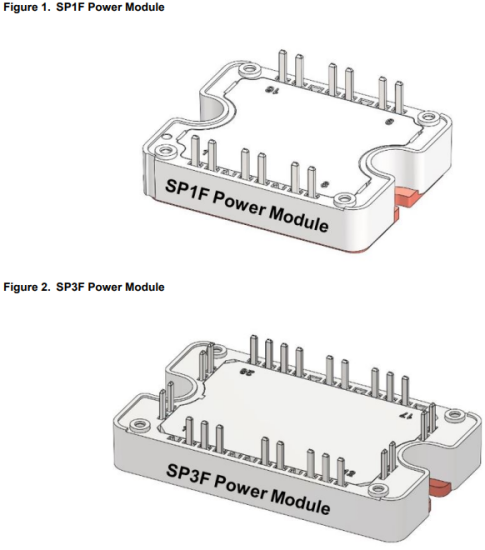
PCB Mounting Instructions
The PCB mounted on the power module can be screwed to the standoffs to reduce all mechanical stress and minimize relative movements on the pins that are soldered to the power module.
Step 1: Screw the PCB to the standoffs of the power module.
 A self-tapering plastite screw with a nominal diameter of 2.5 mm is recommended to attach the PCB. A plastite screw, shown in the following figure, is a type of screw specifically designed for use with plastic and other low-density materials. The screw length depends on the PCB thickness. With a 1.6 mm (0.063”) thick PCB, use a plastite screw 6 mm (0.24”) long. The maximum mounting torque is 0.6 Nm (5 lbf·in). Check the integrity of the plastic post after tightening the screws.
A self-tapering plastite screw with a nominal diameter of 2.5 mm is recommended to attach the PCB. A plastite screw, shown in the following figure, is a type of screw specifically designed for use with plastic and other low-density materials. The screw length depends on the PCB thickness. With a 1.6 mm (0.063”) thick PCB, use a plastite screw 6 mm (0.24”) long. The maximum mounting torque is 0.6 Nm (5 lbf·in). Check the integrity of the plastic post after tightening the screws.
 Step 2: Solder all electrical pins of the power module to the PCB as shown in the following figure.
Step 2: Solder all electrical pins of the power module to the PCB as shown in the following figure.
A no-clean solder flux is required to attach the PCB, as the aqueous module cleaning is not allowed.
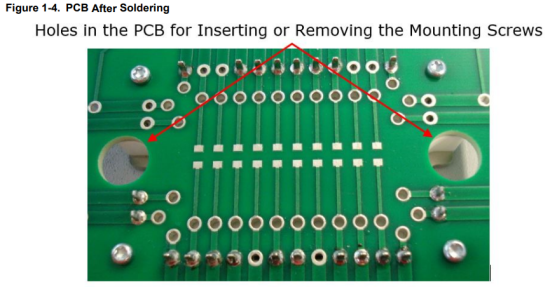
Hlokomela: Do not reverse these two steps, because if all pins are soldered first to the PCB, screwing the PCB to the standoffs creates a deformation of the PCB, leading to some mechanical stress that can damage the tracks or break the components on the PCB.
Holes in the PCB as shown in the preceding figure are necessary to insert or remove the mounting screws that bolt down the power module to the heat sink. These access holes must be large enough for the screw head and washers to pass through freely, allowing for normal tolerance in PCB hole location. The PCB hole diameter for the power pins is recommended at 1.8 ± 0.1 mm. The PCB hole diameter for inserting or removing the mounting screws is recommended at 10 ± 0.1 mm.
For efficient production, a wave soldering process can be used to solder the terminals to the PCB. Each application, heat sink and PCB can be different; wave soldering must be evaluated on a case-by-case basis. In any case, a wellbalanced
layer of solder should surround each pin.
The gap between the bottom of the PCB and the power module is 0.5 mm to 1 mm only as shown in PCB Mounted on Power Module figure. Using through-hole components on the PCB is not recommended. SP1F or SP3F pinout can change according to the configuration. See the product datasheet for more information on the pin-out location.
Power Module Mounting Instructions
Proper mounting of the module base plate onto the heat sink is essential to guarantee good heat transfer. The heat sink and the power module contact surface must be flat (recommended flatness should be less than 50 μm for 100 mm continuous, recommended roughness Rz 10) and clean (no dirt, corrosion, or damage) to avoid mechanical stress when power module is mounted, and to avoid an increase in thermal resistance.
Mohato oa 1: Thermal grease application: To achieve the lowest case to heat sink thermal resistance, a thin layer of thermal grease must be applied between the power module and the heat sink. It is recommended to use screen printing technique to ensure a uniform deposition of a minimum thickness of 60 μm (2.4 mils) on the heat sink as shown in the following figure. The thermal interface between the module and the heat sink can also be made with other conductive thermal interface materials such as phase change compound (screen-printed or adhesive layer).
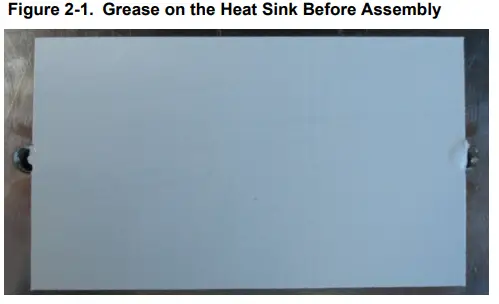
Mohato oa 2: Mounting the power module onto the heat sink: Place the power module above heat sink holes and apply a small pressure to it. Insert the M4 screw with lock and flat washers in each mounting hole (a #8 screw can be used instead of M4). The screw length must be at least 12 mm (0.5”). First, lightly tighten the two mounting screws. Tighten alternatively the screws until their final torque value is reached (see the product datasheet for the maximum torque allowed). It is recommended to use a screwdriver with controlled torque for this operation. If possible, screws can be tightened again after three hours. The quantity of thermal grease is correct when a small amount of grease appears around the power module once it is bolted down onto the heat sink with the appropriate mounting torque. The lower surface of the module must be completely wet with thermal grease as shown in the Grease on the Module After Disassembling figure. The gap between the screws, top height and the nearest terminal must be checked to maintain safe insulation spacing.

Seboka se Akaretsang View
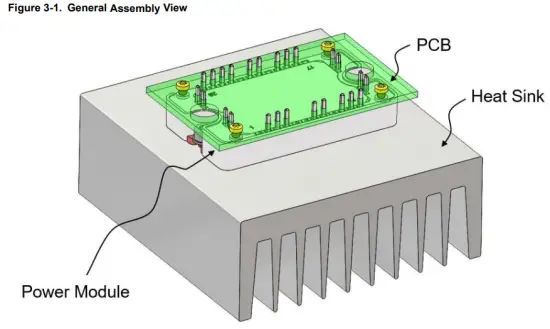 If a large PCB is used, additional spacers between the PCB and the heat sink are necessary. It is recommended to keep a distance of at least 5 cm between the power module and the spacers as shown in the following figure. The spacers must be of the same height as the standoffs (12 ± 0.1 mm).
If a large PCB is used, additional spacers between the PCB and the heat sink are necessary. It is recommended to keep a distance of at least 5 cm between the power module and the spacers as shown in the following figure. The spacers must be of the same height as the standoffs (12 ± 0.1 mm).
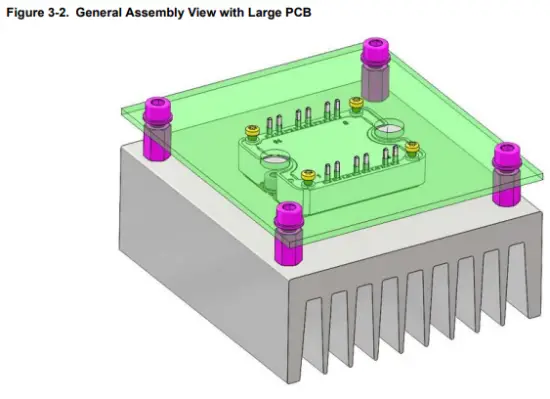
For specific applications, some SP1F or SP3F power modules are manufactured with an AlSiC (Aluminium Silicon Carbide) baseplate (M suffix in the part number). AlSiC baseplate is 0.5 mm thicker than the copper baseplate, so the spacers must be 12.5 ± 0.1 mm in thickness.
The SP1F and SP3F plastic frame height is the same height as a SOT-227. On the same PCB, if a SOT-227 and one or several SP1F/SP3F power modules with copper baseplate are used, and if the distance between the two power modules does not exceed 5 cm, it is not necessary to install the spacer as shown in the following figure.
If a SP1F/SP3F power modules with AlSiC baseplate is used with a SOT-227 or other SP1F/SP3F modules with copper baseplate, the heatsink height must be reduced by 0.5 mm under the SP1F/SP3F modules with an AlSiC baseplate to maintain all the module standoffs at the same height.
Care must be taken with heavy components like electrolytic or polypropylene capacitors, transformers, or inductors. If these components are located in the same area, it is recommended to add spacers even if the distance between two modules does not exceed 5 cm such that, the weight of these components on the board is not handled by the power module but by the spacers. In any case, each application, heat sink, and PCB are different; the spacers placement must be evaluated on a case-by-case basis.
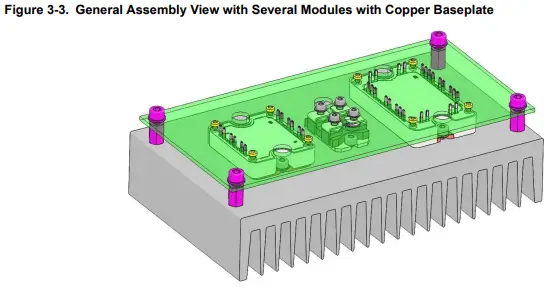
Qetello
This application note gives the main recommendations regarding the mounting of SP1F or SP3F modules. Applying these instructions helps decrease the mechanical stress on PCB and power module, while ensuring long term operation of the system. Mounting instructions to the heat sink must also be followed to achieve the lowest thermal resistance from the power chips down to the cooler. All these steps are essential to guarantee the best system reliability.
Nalane ea Phetoho
Nalane ea ntlafatso e hlalosa liphetoho tse kentsoeng tšebetsong tokomaneng. Liphetoho li thathamisitsoe ka ntlafatso, ho qala ka khatiso ea morao-rao.
| Khatiso | Letsatsi | Tlhaloso |
| A | Mots'eanong-20 | Ena ke tokollo ea pele ea tokomane ena. |
Microchip Websebaka
Microchip e fana ka tšehetso ea inthaneteng ka rona websaete ho www.microchip.com/. Sena websebaka se sebedisoang ho etsa files le tlhahisoleseding e fumaneha habonolo ho bareki. Tse ling tsa litaba tse fumanehang li kenyelletsa:
- Tšehetso ea Sehlahisoa - Lipampiri tsa data le errata, lintlha tsa kopo le sample mananeo, lisebelisoa tsa moralo, litataiso tsa basebelisi le litokomane tsa tšehetso ea hardware, lintlafatso tsa morao-rao tsa software le li-archived software
- Tšehetso e Akaretsang ea Tekheniki - Lipotso Tse Botsoang Khafetsa (FAQs), likopo tsa tšehetso ea tekheniki, lihlopha tsa lipuisano tsa inthaneteng, lethathamo la litho tsa lenaneo la balekane ba Microchip
- Khoebo ea Microchip - Mokhethoa oa lihlahisoa le litataiso tsa ho odara, likhatiso tsa morao-rao tsa khatiso tsa Microchip, lethathamo la lithupelo le liketsahalo, lethathamo la liofisi tsa thekiso ea Microchip, barekisi le baemeli ba feme.
Ts'ebeletso ea Tsebiso ea Phetoho ea Sehlahisoa
Ts'ebeletso ea tsebiso ea phetoho ea sehlahisoa sa Microchip e thusa ho boloka bareki ba le teng ka lihlahisoa tsa Microchip. Ba ngolisitseng ba tla fumana tsebiso ea lengolo-tsoibila neng kapa neng ha ho na le liphetoho, lintlafatso, lintlafatso kapa liphoso tse amanang le sehlahisoa se itseng sa lelapa kapa sesebelisoa sa ntlafatso sa thahasello. Ho ngolisa, ea ho www.microchip.com/pcn mme o latele ditaelo tsa ngodiso.
Tšehetso ea Bareki
Basebelisi ba lihlahisoa tsa Microchip ba ka fumana thuso ka likanale tse 'maloa:
- Morekisi kapa Moemedi
- Ofisi ea Thekiso ea Lehae
- Embedded Solutions Engineer (ESE)
- Tšehetso ea tekheniki
Bareki ba lokela ho ikopanya le mofani oa bona oa thepa, moemeli kapa ESE bakeng sa tšehetso. Liofisi tsa thekiso ea lehae le tsona li teng ho thusa bareki. Lethathamo la liofisi tsa thekiso le libaka li kenyelelitsoe tokomaneng ena.
Tšehetso ea tekheniki e fumaneha ka ho websebaka ho: www.microchip.com/support
Karolo ea Tšireletso ea Khoutu ea Lisebelisoa tsa Microchip
Hlokomela lintlha tse latelang tsa ts'ireletso ea khoutu ho lisebelisoa tsa Microchip:
- Lihlahisoa tsa Microchip li kopana le litlhaloso tse fumanehang ho Microchip Data Sheet ea tsona.
- Microchip e lumela hore lelapa la eona la lihlahisoa ke le leng la malapa a sireletsehileng ka ho fetisisa a mofuta oa lona 'marakeng kajeno, ha a sebelisoa ka mokhoa o reriloeng le tlas'a maemo a tloaelehileng.
- Ho na le mekhoa e sa tšepahaleng le mohlomong e seng molaong e sebelisoang ho tlola tšobotsi ea ts'ireletso ea khoutu. Mekhoa ena kaofela, ho ea ka tsebo ea rona, e hloka ho sebelisa lihlahisoa tsa Microchip ka mokhoa o kantle ho lintlha tsa ts'ebetso tse fumanehang ho Microchip's Data Sheets. Ho ka etsahala hore ebe motho ea etsang joalo o utsoa thepa ea bohlale.
- Microchip e ikemiselitse ho sebetsa le moreki ea amehileng ka botšepehi ba khoutu ea bona.
- Ha ho Microchip kapa moetsi ofe kapa ofe oa semiconductor ea ka netefatsang ts'ireletso ea khoutu ea bona.
Code protection does not mean that we are guaranteeing the product as “unbreakable.” Code protection is constantly evolving. We at Microchip are committed to continuously improving the code protection features of our products. Attempts to break Microchip’s code protection feature may be a violation of the Digital Millennium Copyright Act. If such acts allow unauthorized access to your software or other copyrighted work, you may have a right to sue for relief under that Act.
Tsebiso ea Molao
Information contained in this publication regarding device applications and the like is provided only for your convenience and may be superseded by updates. It is your responsibility to ensure that your application meets with your specifications. MICROCHIP MAKES NO REPRESENTATIONS OR WARRANTIES OF ANY KIND WHETHER EXPRESS OR IMPLIED, WRITTEN OR ORAL, STATUTORY OR OTHERWISE, RELATED TO THE INFORMATION,
INCLUDING BUT NOT LIMITED TO ITS CONDITION, QUALITY, PERFORMANCE, MERCHANTABILITY OR FITNESS FOR PURPOSE. Microchip disclaims all liability arising from this information and its use. Use of Microchip devices in life support and/or safety applications is entirely at the buyer’s risk, and the buyer agrees to defend, indemnify and hold harmless Microchip from any and all damages, claims, suits, or expenses resulting from such use. No licenses are conveyed, implicitly or otherwise, under any Microchip intellectual property rights unless otherwise stated.
Matšoao a khoebo
Lebitso la Microchip le logo, logo ea Microchip, Adaptec, AnyRate, AVR, logo ea AVR, AVR Freaks, BesTime, BitCloud, chipKIT, chipKIT logo, CryptoMemory, CryptoRF, dsPIC, FlashFlex, flexPWR, HELDO, IGLOO, JukeLox, KK , LANCheck, LinkMD, maXStylus, maXTouch, MediaLB, megaAVR, Microsemi, Microsemi logo, MOST, MOST logo, MPLAB, OptoLyzer, PackeTime, PIC, picoPower, PICSTART, PIC32 logo, PolarFire, Moqapi oa Prochip, QTouch, SAM-BA, SAM-BA , SpyNIC, SST, SST Logo, SuperFlash, Symmetricom, SyncServer, Tachyon, TempTrackr, TimeSource, tinyAVR, UNI/O, Vectron, le XMEGA ke matshwao a kgwebo a ngodisitsweng a Microchip Technology Incorporated USA le dinaheng tse ding.
APT, ClockWorks, The Embedded Control Solutions Company, EtherSynch, FlashTec, Hyper Speed Control, Hyperlight Load, Intel limos, Libero, motorBench, mTouch, Powermite 3, Precision Edge, ProASIC, ProASIC Plus, ProASIC Plus logo, Quiet-Wire, SmartFusion, SyncWorld, Temux, TimeCesium, TimeHub, TimePictra, TimeProvider, Vite, WinPath, and ZL are registered trademarks of Microchip Technology Incorporated in the U.S.A. Adjacent Key Suppression, AKS, Analog-for-the-Digital Age, Any Capacitor, AnyIn, AnyOut, BlueSky, BodyCom, CodeGuard, CryptoAuthentication, Crypto Automotive, Crypto Companion, Crypto Controller, dsPICDEM, dsPICDEM.net, Dynamic Average Matching, DAM, ECAN, EtherGREEN, In-Circuit Serial Programming, ICSP, INICnet, Inter-Chip Connectivity, Jitter Blocker, KleerNet, KleerNet logo, memBrain, Mindi, MiWi, MPASM, MPF, MPLAB Certified logo, MPLIB, MPLINK, MultiTRAK, NetDetach, Omniscient Code Generation, PICDEM, PICDEM.net, PICkit, PICtail, PowerSmart, PureSilicon, QMatrix, REAL ICE, Ripple Blocker, SAM-ICE, Serial Quad I/O, SMART-I.S., SQI, SuperSwitcher, SuperSwitcher II, Total Endurance, TSHARC, USBCheck, VariSense, ViewSpan, WiperLock, Wireless DNA, le ZENA ke matshwao a kgwebo a Microchip Technology Incorporated USA le dinaheng tse ding.
SQTP is a service mark of Microchip Technology Incorporated in the U.S.A. The Adaptec logo, Frequency on Demand, Silicon Storage Technology, and Symmcom are registered trademarks of Microchip Technology Inc. in other countries.
GestIC ke letshwao la kgwebo le ngodisitsweng la Microchip Technology Germany II GmbH & Co. KG, e leng lekala la Microchip Technology Inc., dinaheng tse ding.
Matšoao a mang kaofela a boletsoeng mona ke thepa ea lik'hamphani tse fapaneng.
© 2020, Microchip Technology Incorporated, E hatisitsoeng USA, Litokelo Tsohle Li Sirelelitsoe. ISBN: 978-1-5224-6145-6
Tsamaiso ea Tsamaiso ea Boleng
Ho fumana leseli mabapi le Tsamaiso ea Tsamaiso ea Boleng ea Microchip, ka kopo etela www.microchip.com/quality.
Lithekiso le Tšebeletso ea Lefatše Lohle
| LIMAKASE | ASIA/PACIFIC | ASIA/PACIFIC | ULAYA |
| Ofisi ea Khoebo 2355 West Chandler Blvd. Chandler, AZ 85224-6199 Mohala: 480-792-7200 Fax: 480-792-7277 Tšehetso ea tekheniki: www.microchip.com/support Web Aterese: www.microchip.com Atlanta Duluth, GA Mohala: 678-957-9614 Fax: 678-957-1455 Austin, TX Mohala: 512-257-3370 Boston Westborough, MA Mohala: 774-760-0087 Fax: 774-760-0088 Chicago Itasca, IL Mohala: 630-285-0071 Fax: 630-285-0075 Dallas Addison, TX Mohala: 972-818-7423 Fax: 972-818-2924 Detroit Novi, MI Mohala: 248-848-4000 Houston, TX Mohala: 281-894-5983 Indianapolis Noblesville, IN Mohala: 317-773-8323 Fax: 317-773-5453 Mohala: 317-536-2380 Los Angeles Mission Viejo, CA Mohala: 949-462-9523 Fax: 949-462-9608 Mohala: 951-273-7800 Raleigh, NC Mohala: 919-844-7510 New York, NY Mohala: 631-435-6000 San Jose, CA Mohala: 408-735-9110 Mohala: 408-436-4270 Canada - Toronto Mohala: 905-695-1980 Fax: 905-695-2078 |
Australia - Sydney Mohala: 61-2-9868-6733 China - Beijing Mohala: 86-10-8569-7000 China - Chengdu Mohala: 86-28-8665-5511 China - Chongqing Mohala: 86-23-8980-9588 China - Dongguan Mohala: 86-769-8702-9880 China - Guangzhou Mohala: 86-20-8755-8029 China - Hangzhou Mohala: 86-571-8792-8115 China - Hong Kong SAR Mohala: 852-2943-5100 China - Nanjing Mohala: 86-25-8473-2460 China - Qingdao Mohala: 86-532-8502-7355 China - Shanghai Mohala: 86-21-3326-8000 China - Shenyang Mohala: 86-24-2334-2829 China - Shenzhen Mohala: 86-755-8864-2200 China - Suzhou Mohala: 86-186-6233-1526 China - Wuhan Mohala: 86-27-5980-5300 China - Xian Mohala: 86-29-8833-7252 China - Xiamen Mohala: 86-592-2388138 China - Zhuhai Mohala: 86-756-3210040 |
India - Bangalore Mohala: 91-80-3090-4444 India - New Delhi Mohala: 91-11-4160-8631 India - Pune Mohala: 91-20-4121-0141 Japane - Osaka Mohala: 81-6-6152-7160 Japane - Tokyo Mohala: 81-3-6880-3770 Korea - Daegu Mohala: 82-53-744-4301 Korea - Seoul Mohala: 82-2-554-7200 Malaysia - Kuala Lumpur Mohala: 60-3-7651-7906 Malaysia - Penang Mohala: 60-4-227-8870 Philippines - Manila Mohala: 63-2-634-9065 Singapore Mohala: 65-6334-8870 Taiwan - Hsin Chu Mohala: 886-3-577-8366 Taiwan - Kaohsiung Mohala: 886-7-213-7830 Taiwan - Taipei Mohala: 886-2-2508-8600 Thailand - Bangkok Mohala: 66-2-694-1351 Vietnam - Ho Chi Minh Mohala: 84-28-5448-2100 |
Austria - Wels Mohala: 43-7242-2244-39 Fax: 43-7242-2244-393 Denmark - Copenhagen Mohala: 45-4485-5910 Fax: 45-4485-2829 Finland - Espoo Mohala: 358-9-4520-820 Fora - Paris Tel: 33-1-69-53-63-20 Fax: 33-1-69-30-90-79 Jeremane - Ho khabisa Mohala: 49-8931-9700 Jeremane - Haan Mohala: 49-2129-3766400 Jeremane - Heilbronn Mohala: 49-7131-72400 Jeremane - Karlsruhe Mohala: 49-721-625370 Jeremane - Munich Tel: 49-89-627-144-0 Fax: 49-89-627-144-44 Jeremane - Rosenheim Mohala: 49-8031-354-560 Iseraele - Ra'anana Mohala: 972-9-744-7705 Italy - Milan Mohala: 39-0331-742611 Fax: 39-0331-466781 Italy - Padova Mohala: 39-049-7625286 Netherlands - Drunen Mohala: 31-416-690399 Fax: 31-416-690340 Norway - Trondheim Mohala: 47-72884388 Poland - Warsaw Mohala: 48-22-3325737 Romania - Bucharest Tel: 40-21-407-87-50 Spain - Madrid Tel: 34-91-708-08-90 Fax: 34-91-708-08-91 Sweden - Gothenberg Tel: 46-31-704-60-40 Sweden - Stockholm Mohala: 46-8-5090-4654 UK - Wokingham Mohala: 44-118-921-5800 Fax: 44-118-921-5820 |
© 2020 Microchip Technology Inc.
Application Note DS00003500A-page 10
Litokomane / Lisebelisoa
 |
MICROCHIP SP1F, SP3F Power Modules [pdf] Buka ea Taelo AN3500, SP1F SP3F Power Modules, SP1F SP3F, Power Modules, Modules |